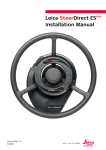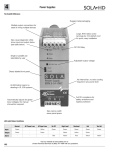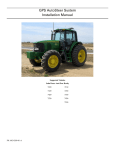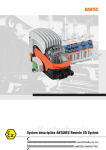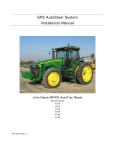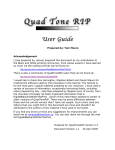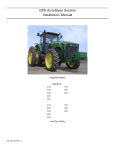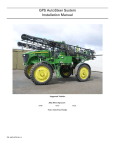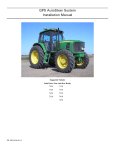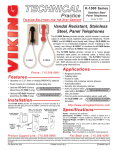Download 602-0199-01
Transcript
GPS AutoSteer System Installation Manual John Deere AutoTrac Ready Articulated Supported Models 9120 9220 9320 9420 9520 9620 PN: 602-0199-01-A 9230 9330 9430 9530 9630 Legal Disclaimer Note: Read and follow ALL instructions in this manual carefully before installing or operating the AutoSteer system. Note: Take careful note of the safety information in the Safety Information section and throughout this manual. The manufacturer disclaims any liability for damage or injury that results from failure to follow the instructions and warnings set forth herein. Please take special note of the following warnings: 1. There is NO obstacle avoidance system included in the manufacturer’s product. Therefore, users must always have an operator on the equipment when the AutoSteer system is in use to look for any obstacles including people, animals, trees, ditches, buildings, etc. 2. During installation of the AutoSteer system and during the Calibration and Tuning processes the vehicle will pivot at the articulation point from side to side and the vehicle moves. Be sure that all people and obstacles are clear of the vehicle before installation, calibration and tuning, or use of the AutoSteer system. 3. Use of the AutoSteer system is NOT permitted while the vehicle is on public roads or in public areas. Ensure that the system is OFF before driving on roads or in public areas. 2 AutoSteer System Tools This list consists of the tools required to complete the installation. The installer is assumed to have a complete set of common installation tools. #1 Phillips screwdriver 3/8” Open wrench 8mm socket and ratchet #2 Phillips screwdriver 1/2” Open wrench 10mm socket and ratchet #3 Phillips screwdriver 9/16” Open wrench 15mm socket and ratchet 1/8” Allen wrench Cable puller pole 16mm socket and ratchet 5/32” Allen wrench Tape measure, 12ft (3.6 m) minimum 17mm socket and ratchet 9/16” socket and ratchet Step ladder, 10 ft (3.0 m) minimum 18mm socket and ratchet 15/16” socket and ratchet Wire cutter small Metal hacksaw Ohm meter Cleaning brush Cleaning rags Hardware Installation Guide 3 4 AutoSteer System Hardware Installation Guide 5 6 AutoSteer System Hardware Installation Guide 7 Important Information Note: Verify that all screws, bolts, nuts, hose connections and cable connections are tight after the final installation of the AutoSteer system on the vehicle. . Technical Support Refer to your owner's manual for technical support information. Contact Information Refer to your owner's manual for contact information. 8 AutoSteer System Table of Contents 1 Installation Overview.................................................................................................................................................... 11 Installation Kit Overview.......................................................................................................................................... 11 Installation Procedure Outline ................................................................................................................................. 16 Cable Diagram ......................................................................................................................................................... 17 2 Wheel Angle Sensor Installation (Optional) ............................................................................................................... 19 Wheel Angle Sensor Overview.................................................................................................................................. 19 Wheel Angle Sensor Installation Procedure............................................................................................................. 20 3 SA Module Installation................................................................................................................................................. 39 SA Module Mounting Orientation ............................................................................................................................ 39 Mount the SA Module on 9X20 Series ...................................................................................................................... 40 Mount the SA Module on 9X30 Series ...................................................................................................................... 42 4 Roof Module Installation.............................................................................................................................................. 45 Safety Notes .............................................................................................................................................................. 45 Roof Rail Installation ............................................................................................................................................... 45 5 Display Installation ....................................................................................................................................................... 51 Introduction .............................................................................................................................................................. 51 9X20 Series Installation Procedure.......................................................................................................................... 51 9X30 Series Installation Procedure.......................................................................................................................... 53 6 Connecting System Cables ........................................................................................................................................... 55 SA Module Harness .................................................................................................................................................. 56 Main Cable Harness................................................................................................................................................. 73 7 Post-Installation Procedures and Information ........................................................................................................... 81 Create New Vehicle .................................................................................................................................................. 81 Calibration and Tuning Notes .................................................................................................................................. 81 8 Final Hardware Installation Checklist........................................................................................................................ 83 Hardware Installation Guide 9 10 AutoSteer System 1 Installation Overview The Installation Overview chapter information is provided in the following sections: • Installation Kit Overview • • • Sub-Assemblies • John Deere AutoTrac Ready Common Kit Components • Bracket Kit Component • AutoTrac Terminator Kit Component Installation Procedure Outline Cable Diagram This installation guide describes the installation of the AutoSteer system on several models of John Deere AutoTrac Ready Articulated vehicles. The AutoSteer installation kit PN: 188-0012-01 is used on the following models: • • John Deere 9X20 Series (9120, 9220, 9320, 9420, 9520, and 9620) John Deere 9X30 Series (9230, 9330, 9430, 9530 and 9630) The vehicle specific sub-assemblies for the vehicle series are listed in Table 1-1. Note: If you are installing an electric steering wheel actuator such as OnTrac II, skip SA Module and SA Module Harness installation information in this book and refer to your electric steering product manual for further instructions. Installation Kit Overview This Installation Kit Overview section is divided into sub-sections for each of the two sub-assemblies as shown in Figure 1-1. The components in each sub assembly are described in the following sections. Hardware Installation Guide 11 Figure 1-1 Installation Kit Components (PN: 188-0012-01) Table 1-1 Installation Kit Component Descriptions (PN: 188-0012-01) Item Component Part Number 1. John Deere AT Ready Common Kit 153-0002-01 2. John Deere 9XX0 Bracket Kit 152-0011-01 Sub-Assemblies This vehicle installation kit contains the following components: • John Deere AutoTrac Ready Common Kit Components • Bracket Kit Components • AutoTrac Termination Kit Components 12 AutoSteer System John Deere AutoTrac Ready Common Kit Components Figure 1-2 John Deere AutoTrac Ready Common Kit Components (153-0002-01) Table 1-2 John Deere AutoTrac Ready Common Kit Components (153-0002-01) Item Component Part Number 1. SA Module Assembly – Wheeled 200-0206-01 2. SA Module Harness – AutoTrac Ready 201-0240-02 3. Assembly Kit – Common 200-0497-02 4. SA Module Bracket Assembly 200-0190-01 5. Cable Routing Hardware 200-0076-01 6. Kit – RAM Base with Screws 200-0508-01 7. Attention Switch Off Label 603-0074-01 Hardware Installation Guide 13 Bracket Kit Components Figure 1-3 Bracket Kit Components (PN: 152-0011-01) Table 1-3 Bracket Kit Components (PN: 152-0011-01) Item Component Part Number 1. User Display Bracket Kit 200-0469-02 2. Roof Module Mounting Kit 200-0238-01 3. Install Manual 602-0199-01 4. AutoTrac Terminator Kit – 9XX0 200-0314-02 14 AutoSteer System AutoTrac Termination Kit Components Figure 1-4 AutoTrac Termination Kit Components (PN: 200-0314-02) Table 1-4 AutoTrac Termination Kit Components (PN: 200-0314-02) Item Component Part Number When to Use 1. Steering Encoder Terminator (High) 201-0241-01 All 2. Steering Encoder Terminator (Low) 201-0242-01 All 3. Cables Ties 510-0015-01 All 4. Vehicle WAS Sensor Terminator 201-0243-01 9X20 installation 5. AutoSteer Wheel Angle Sensor Cable Adapter 201-0472-01 9X30 installation 6. Vehicle WAS Sensor Terminator 201-0473-01 9X30 installation Hardware Installation Guide 15 Installation Procedure Outline 1. Verify that all components have been received. Note: Step 2, Step 3 and Step 7 are skipped if installing an electric steering actuator. 2. Install the Wheel Angle Sensor. (Optional) 3. Install the SA Module. 4. Install the Roof Rail on the cab roof. 5. Install the Roof Module on the roof rail. 6. Install the Monitor Mounting bracket in the cab 7. Install the SA Module harness. 8. Install the Main Cable harness. 9. Install the display using a RAM mount arm. 10. Connect the Main Cable harness to the display harness (Power, DB9 serial, RJ-45) Note: Instructions for connecting the vehicle kit cables to the display can be found in the display owner's manual. 11. Verify that all connectors are properly coupled and secured. 12. Power ON the AutoSteer system. 13. Calibrate the vehicle. 14. Tune the vehicle. 15. Verify the system has been installed properly and operates satisfactorily. 16 AutoSteer System Cable Diagram Hardware Installation Guide 17 18 AutoSteer System 2 Wheel Angle Sensor Installation (Optional) The Wheel Angle Sensor Installation chapter information is provided in the following section: • • Wheel Angle Sensor Overview Wheel Angle Sensor Installation Procedure • Mount the Brackets on 9X20 Series • Mount the Brackets on 9X30 Series • Cut the Wheel Angle Sensor Rods to Length • Assemble the Linkage Rod Hardware • Attach Wheel Angle Sensor Rods to Brackets and Adjust The Wheel Angle Sensor is an optional accessory and is not provided with the installation kit. The Wheel Angle Sensor installation instructions are provided only for guidance if the Wheel Angle Sensor is installed. The decision to use the Wheel Angle Sensor is left up to the installer and customer. The 9X20 Series vehicles were released with two different rear frames. The earlier models were released with the standard rear frame. The later models came from the factory with a cast iron rear frame similar to frame on the 9X30 Series. This installation kit will work on both frame types. Wheel Angle Sensor Overview In order to add a Wheel Angle Sensor to this vehicle, additional parts are required. Contact your AutoSteer dealer to get the current part numbers and to order if installing the AutoSteer Wheel Angle Sensor kit. Table 2-1 provides the parts that are required as a reference. Table 2-1 John Deere 9X00, 9X20, and 9X30 Wheel Angle Sensor Kit Component Part Numbers Item Component Part Number 1. Wheel Angle Sensor Assembly Kit 200-0468-01 2. JD-9X00 9X20 9X30 Wheel Angle Sensor Brackets 200-0253-02 Wheel Angle Sensor Installation Procedure Mounting the Brackets on 9X20 Series 1. Identify the Wheel Angle Sensor mounting location. The Wheel Angle Sensor bracket is mounted on right side of the vehicle near the pivot point. Figure 2-11 shown the right side of a standard rear frame. Figure 2-2 shows the right side of a cast iron rear frame. Figure 2-1 Wheel Angle Sensor Mounting Position Standard Rear Frame Figure 2-2 Wheel Angle Sensor Mounting Position Cast Iron Rear Frame 20 AutoSteer System 2. Assemble the Wheel Angle Sensor mounting bracket as shown in Figure 2-3. Attach the bracket arm to the mounting bracket with the four 3/8” x 1” bolts, washers, and lock nuts. Tighten the bolts with a 9/16” wrench and 9/16” socket and ratchet. Figure 2-3 3. Assemble Wheel Angle Sensor Bracket Locate the exiting bolts used to mount the Wheel Angle Sensor bracket shown in Figure 2-4. Note: These bolts are the same for the standard and cast iron rear frames. The cast iron rear frame is shown. 4. Remove the grounding strap bolt with a 16mm socket and ratchet. Remove the top fuel tank bracket bolt with an 18mm socket and ratchet. Figure 2-4 Wheel Angle Sensor Mounting Bolts Remove Grounding Strap Bolt Remove Fuel Tank Mounting Bracket Bolt Hardware Installation Guide 21 5. Attach the Wheel Angle Sensor bracket to the vehicle so that the top horizontal slot is held by the grounding strap bolt and the bottom vertical slot is held by the fuel tank mounting bracket bolt. The grounding strap should be attached behind the zinc plated mounting bracket as shown in Figure 2-5. The bracket should angle towards the rear of the machine. 6. Tighten the grounding strap bolt with a 16mm socket and ratchet and the fuel tank mounting bolt with an 18mm socket and ratchet. Figure 2-5 shows the bracket attached Note: As the grounding strap is reattached, it is possible that some sparks may happen. This will not hurt anything. Figure 2-5 7. Wheel Angle Sensor Brackett Attached Attach the Wheel Angle Sensor to the Wheel Angel Sensor bracket as shown in Figure 2-6. Tighten the bolts with a 9/16” socket and ratchet. Figure 2-6 Attach Wheel Angle Sensor Bolts Attach from the Front 22 AutoSteer System Note: The linkage arm bracket mounting location is in approximately the same place for both the standard and cast iron rear frames. However, the way the bracket is mounted is different. Follow the instructions for the specific rear end that is present on the vehicle 8. Locate the wheel angle sensor linkage arm mounting location. Figure 2-7 shows the location of the mounting point on a standard rear frame vehicle. Figure 2-8 shows the location of the mounting point on a cast iron rear frame vehicle. Figure 2-7 Standard Rear Frame Linkage Bracket Mounting Location (shown from the right side of vehicle) Figure 2-8 Cast Iron Rear Frame Linkage Bracket Mounting Location (shown from left side of vehicle) Hardware Installation Guide 23 9. Attach the Wheel Angle Sensor rod linkage bracket to the mounting points. a. When connecting to the standard rear frame, remove the bolts one at a time with a 16mm socket and ratchet and attach the bracket as shown in Figure 2-9. Figure 2-9 b. Linkage Bracket Mounted on Standard Rear Frame When connecting to the cast iron rear frame, place the bracket over the existing bolts and secure the bracket with the two M10 lock nuts provided with the installation kit as shown in Figure 2-10. Tighten the nuts with a 17mm socket and ratchet. Note: The bolts should be long enough to attach the bracket without removing them. Figure 2-10 Linkage Bracket Mounted on Cast Iron Rear Frame 24 AutoSteer System Mounting the Brackets on 9X30 Series 1. Identify the Wheel Angle Sensor mounting location. The Wheel Angle Sensor bracket is mounted on right side of the vehicle near the pivot point shown in Figure 2-11. Figure 2-11 Wheel Angle Sensor Mounting Position 2. Assemble the Wheel Angle Sensor mounting bracket as shown in Figure 2-12. Attach the bracket arm to the mounting bracket with the four 3/8” x 1” bolts, washers, and lock nuts. Tighten the bolts with a 9/16” wrench and 9/16” socket. Figure 2-12 Assemble Wheel Angle Sensor Bracket Hardware Installation Guide 25 Note: The attachment of the Wheel Angle Sensor bracket requires that a bolt that holds the fuel tank to the side of the vehicle be removed temporarily. The clamp that is removed helps to hold the tank in the proper shape when it is full. Removing this clamp with the fuel tank full will result in the tank becoming deformed, thus making it difficult to reattach and possibly damaging the fuel tank. The fuel tank must be less than 1/4 full prior to installing the Wheel Angle Sensor. 3. Locate the Wheel Angle Sensor mounting bolts as shown in Figure 2-13. 4. Remove the grounding strap bolt with a 15mm socket and ratchet. Remove the fuel tank bracket bolt with an 18mm socket and ratchet. Figure 2-13 Wheel Angle Sensor Mounting Position Remove Grounding Strap Bolt Remove Fuel Tank Mounting Bracket Bolt 26 AutoSteer System 5. Attach the Wheel Angle Sensor bracket to the vehicle so that the top vertical slot is held by the grounding strap bolt and the bottom horizontal slot is held by the fuel tank mounting bracket bolt. The grounding strap can be attached to the top of the bracket. The bracket should angle towards the rear of the machine. 6. Tighten the grounding strap bolt with a 15mm socket and ratchet and the fuel tank mounting bolt with an 18mm socket and ratchet. See Figure 2-14. Note: As the grounding strap is reattached, it is possible that some sparks may happen. This will not hurt anything. Figure 2-14 9X30 Wheel Angle Sensor Brackett Attached 7. Attach the Wheel Angle Sensor to the Wheel Angel Sensor bracket as shown in Figure 2-15. Tighten the bolts with a 9/16” socket and ratchet. Figure 2-15 Attach Wheel Angle Sensor Bolts Attach from the Front Hardware Installation Guide 27 8. Locate the wheel angle sensor linkage arm mounting location shown in Figure 2-16. Figure 2-16 Wheel Angle Sensor Linkage Rod Mounting Location 9. Attach the Wheel Angle Sensor rod linkage bracket to the existing bolts with the two M10 lock nuts provided with the installation kit as shown in Figure 2-17. Tighten the nuts with a 17mm socket and ratchet. Note: The bolts should be long enough to attach the bracket without removing them. Figure 2-17 Wheel Angle Sensor Linkage Rod Bracket Mounted 28 AutoSteer System Cut the Wheel Angle Sensor Rods The Wheel Angle Sensor rods are shipped longer than they need to be. These rods must be cut to the proper length to allow the linkage rods to provide the Wheel Angle Sensor the maximum number of counts as the steering wheel is turned from full right to full left. Due to the variability of the possible mounting positions and axle options, it is the responsibility of the installer to verify the correct length for each individual installation and to cut the rods to the proper length. Table 2-2 provides the typical rod lengths that work for most installations. Before cutting the linkage rods to these measurements, verify that the Wheel Angle Sensor brackets can attach to the vehicle as shown in this manual and that they are attached the correct distance from any reference points shown. If the axle does not allow the Wheel Angle Sensor brackets to be installed as shown, do not cut the rods until it is determined what the proper lengths are for your installation. Even if the brackets can be attached as shown, these measurements may need to be slightly different to take into account minor installation differences. These measurements are provided as a reference only. The installer is responsible for verifying that the provided measurements will work prior to cutting the rods. Refer to Figure 2-18 to determine where the measurement points on the rods are taken to get the values provided in Table 2-2. Table 2-2 Linkage Rod Cut Lengths Item Standard Frame Mounting Cast Iron Frame Mounting Rod A 4 inches (102 mm) 4 inches (102 mm) Rod B 7-3/4 inches (197 mm) 7-1/2 inches (191 mm) Figure 2-18 Linkage Rod Cut Length Measurement Points Hardware Installation Guide 29 1. Use a metal hack saw and vice as shown in Figure 2-19 to cut the Wheel Angle Sensor linkage rods to the proper lengths. Note: Protect the threads from damages while cutting the rods. It is advisable to attach a nut on the side of the linkage rod that is going to be kept in order to clean the threads after the cut has been made. Figure 2-19 Linkage Rod Cutting Assemble the Linkage Rod Hardware 1. Attach a jam nut to the end of Rod A. 2. Connect the eye connector to the end of the Wheel Angle Sensor rod as shown in Figure 2-20. Figure 2-20 Rod A Assembled Jam Nut Eye Connector 30 AutoSteer System 3. Attach the jam nuts to each end of the linkage Rod B 4. Attach the ball joints to both ends of the linkage arm as shown in Figure 2-21. Note: The bolts for the ball joints should be facing the same direction as shown in Figure 2-21 for installations on the cast iron rear frame. However on installation on standard rear frames, the ball joints should be facing in opposite directions. Figure 2-21 Linkage Rod Assembled Jam Nuts Ball Joints Hardware Installation Guide 31 5. For most installations, use Table 2-3 to adjust the lengths of the rod assemblies to the values shown. Figure 2-22 shows where the measurement points for each rod are taken. Note: Due to the variation of axle types and installation points, these measurements are provided as a reference only. Before connecting the steering rods and turning the steering axle verify that these lengths will work and the sensor will not be damaged. Table 2-3 Assembled Linkage Rod Length Item Standard Frame Mounting Cast Iron Frame Mounting Rod A 4-3/4 inches (121 mm) 4-3/4 inches (121 mm) Rod B 9-3/4 inches (248 mm) 9-3/8 inches (238 mm) Figure 2-22 Assembled Linkage Rod Measurement Points 32 AutoSteer System Attach Wheel Angle Sensor Rods to Brackets and Adjust 1. Attach the Wheel Angle Sensor rod to the Wheel Angle Sensor. The rod will point towards the right side of the vehicle. Note: The flat washer goes on the bolt head side and NOT the nut side when attaching the arm. See Figure 2-23. Figure 2-23 Washer on Shaft Bolt Nut Flat Washer Allen Bolt Head 2. Tighten the bolt on the Wheel Angle Sensor shaft with a 1/8” Allen wrench and a 3/8” open end wrench. 3. Attach the linkage rod to the linkage bracket. a. When installing on a standard rear frame, the bolt attaches from above the “L” bracket and the lock washer and nut go on the bottom. Tighten the ball joint to the bracket with 1/2" and 9/16” wrenches. Figure 2-24 shows both rods connected to the brackets. Figure 2-24 Linkage Connections on Standard Frame Installations Hardware Installation Guide 33 b. When installing on a cast iron rear frame, the bolt attaches from below the “L” bracket and the nut and lock washer go on top. Tighten the ball joint to the bracket with 1/2" and 9/16” wrenches. Figure 2-25 shows both rods connected to the brackets. Figure 2-25 Linkage Connections on Cast Iron Frame Installations Note: Never attach the linkage rods to Wheel Angle Sensor rod and turn the steering wheels manually or automatically until the fit has been verified. The linkage rods must remain apart while the steering wheels are turned to the maximum right and left positions and then temporarily attached at these positions. Failure to do this may cause the Wheel Angle Sensor or vehicle to become damaged. Note: Always shut down the vehicle when working around the pivot point when checking and adjusting the Wheel Angle Sensor rod lengths. The vehicle could move suddenly and cause severe injury or death. 34 AutoSteer System 4. With the linkage rods disconnected, start the vehicle and manually turn the steering wheel so that the vehicle will travel straight ahead when moving. 5. Temporarily attach the linkage rods together. 6. Rotate the Wheel Angle Sensor potentiometer on top of the mounting block so that the plastic wire connector is parallel to the Wheel Angle Sensor rod. See Figure 2-26. Figure 2-26 Adjust Potentiometer Angle to Match Straight Ahead Wheel Position Adjust the orientation of potentiometer sensor so that the wire connector is parallel to wheel angle sensor arm when wheels are straight ahead Tire direction in straight ahead position 7. After the potentiometer has been adjusted, tighten the potentiometer bolts with a 3/8” wrench and 5/32” Allen wrench Hardware Installation Guide 35 8. Disconnect the linkage rods and turn the steering wheel manually so the vehicle is pivoted to the full left position. Note: The vehicle may need to be driven a short distance in order to get the steering system to move to the full left position 9. Reattach the linkage assembly and verify that the sensor and linkage rods will not be damaged. Adjust the rod lengths as necessary. Figure 2-27 shows the Wheel Angle Sensor linkages on the cast iron rear frame in the full left position. Figure 2-27 Confirm Maximum Steer Left Position for Cast Iron Rear Frame 36 AutoSteer System 10. Disconnect the linkage rods and turn the steering wheel manually so the vehicle is pivoted to the full right position. Note: The vehicle may need to be driven a short distance in order to get the steering system to move to the full right position 11. Reattach the linkage assembly and verify that the sensor and linkage rods will not be damaged. Adjust the rod lengths as necessary. Figure 2-28 shows the Wheel Angle Sensor linkages on the cast iron rear frame the full right position. Figure 2-28 Confirm Maximum Steer Right Position for Cast Iron Rear Frame Hardware Installation Guide 37 12. Repeat Steps 4 through 11 until the rod lengths have been adjusted and the potentiometer is centered to get the maximum sensor movement. The maximum movement is reached when the Wheel Angle Sensor rod will sweep from approximately 3/16 inch (5mm) from both bolt heads holding the potentiometer on to the mounting block when the wheels are turned to the maximum right and left positions. See Figure 2-29. Note: The bolts should stick out of the bottom of the Wheel Angle Sensor and are used to prevent the sensor from being accidentally over extended by hand. Ensure these bolts are installed correctly. These bolts will not stop the hydraulics from over extending the sensor. Verify the fit prior to manually or automatically moving the Wheel Angle Sensor fully connected. Figure 2-29 Maximum Sensor Movement Potentiometer Screw Stops Wheel Angle Sensor as Seen from the Bottom Full Left Movement Range Full Right Note: An Ohm meter can also be used to determine if there is enough sensor movement. Connect the Ohm meter to pins A and B of the Wheel Angle Sensor. Measure the Ohm reading at the maximum left and right position. After subtracting the smaller number from the larger number, ideally there should be at least a 3.75 Kilo-Ohms change. However with this installation, the maximum range will only get to around 3.00 Kilo-Ohms. The reading should also never go below 1.6 or higher than 6.6 Kilo-Ohms as this is reaching the limits of the potentiometer and could damage the sensor. 13. Once all the adjustments are complete, tighten all lock nuts and bolts on the linkage and Wheel Angle Sensor rod. A 1/2” and two 9/16” wrenches are required to tighten all the connections. 38 AutoSteer System 3 SA Module Installation The SA Module Installation chapter contains information in the following section: • • • SA Module Mounting Orientation Mount the SA Module on 9X20 Series Mount the SA Module on 9X30 Series SA Module Mounting Orientation The SA Module can also only be mounted in certain orientations. Figure 3-1 shows the correct mounting positions and Figure 3-2 shows the improper mounting positions. Figure 3-1 Correct SA Module Mounting Orientations Figure 3-2 Incorrect SA Module Mounting Orientations Due to the variety of options available on vehicles and the possible configuration differences, it may be necessary to install the SA Module in location other than the example shown here. If an alternative location is required, choose a location where the SA Module can be protected from damage from moving parts or crop debris and excessive moisture from weather and cleaning equipment. Mount the SA Module on 9X20 Series 1. Identify the SA Module mounting location on the right side of the vehicle near the pivot point shown in Figure 3-7. Figure 3-3 2. SA Module Mounting Position Remove the lower bolt of the fuel tank bracket shown in Figure 3-8 with an 18mm socket and ratchet. Figure 3-4 Locate SA Module Mounting Position Remove Bolt 40 AutoSteer System 3. Start two of the SA Module mounting screws on the L-bracket side of the SA Module mounting bracket. 4. Attach the SA Module mounting bracket to the frame with the bolt removed earlier as shown in Figure 3-5. Tighten the bolt with an 18mm socket and ratchet. Figure 3-5 SA Module Bracket Installed Bolt securing SA Module Bracket SA Module Mounting Screws Started 5. Attach the SA Module to the SA Module bracket and secure with the other two Phillips screws. Tighten the SA Module to the bracket with a #2 Phillips screwdriver. See Figure 3-6. Figure 3-6 SA Module Mounted Hardware Installation Guide 41 Mount the SA Module on 9X30 Series 1. Identify the SA Module mounting location on the right side of the vehicle near the pivot point shown in Figure 3-7. Figure 3-7 2. SA Module Mounting Position Remove the top bolt of the lower fuel tank bracket shown in Figure 3-8 with an 18mm socket and ratchet. Figure 3-8 Locate SA Module Mounting Position Remove Bolt 42 AutoSteer System 3. Start two of the SA Module mounting screws on the L-bracket side of the SA Module mounting bracket. 4. Attach the SA Module mounting bracket to the frame with the bolt removed earlier as shown in Figure 3-9. Tighten the bolt with an 18mm socket and ratchet. Figure 3-9 SA Module Bracket Installed Bolt Securing SA Module Bracket SA Module Mounting Screws Started 5. Attach the SA Module to the SA Module bracket and secure with the other two Phillips screws. Tighten the SA Module to the bracket with a #2 Phillips screwdriver. See Figure 3-10. Figure 3-10 SA Module Mounted Hardware Installation Guide 43 4 Roof Module Installation The Roof Module Installation chapter contains information in the following sections: • • Safety Notes Roof Rail Installation Safety Notes • • • • • The AutoSteer system must be powered OFF when installing or removing the Roof Module. The Roof Module must always be firmly secured to the roof rail using the hardware provided whenever the vehicle is in operation to prevent the Roof Module from releasing from its bracket and falling. The Roof Module must be removed when transporting the vehicle at speeds above 30 mph (48 km/h). Ensure you are in a stable position on the vehicle platform when removing the Roof Module so that you do not fall or drop the Roof Module. Use a ladder to install the AutoSteer Roof Rail Ensure that you are in a stable position on the vehicle platform when installing or removing the Roof Rail and Roof Module so you do not fall. Roof Rail Installation The 9X20 and 9X30 Models have slightly different cabs. However the same kit will work for all models. Follow the provided instructions no matter which cab style is present. 1. If necessary use a ladder to aid in accessing the roof. The vehicle does have platforms around the cab that can be used instead or in conjunction with the ladder. 2. Locate the two bolts holding the cab cover on to the vehicle as shown in Figure 4-1. Figure 4-1 Mounting Bolts Location Mounting Bolt Locations 3. Remove the bolts with a 15/16” socket and ratchet. Leave the rubber gasket and original flat washer on top of the cab. 4. Bend the radio antenna forward and latch it in the antenna clip to hold it from rubbing on the Roof Module. See Figure 4-2. Figure 4-2 Latching Radio Antenna Antenna Clip 46 AutoSteer System 5. Place four additional M16 flat washers, provided with the installation kit, on top of both of the existing washers as shown in Figure 4-3. Figure 4-3 Install Four Washer on Top of the Existing Washers (Left Side Shown) Four Flat Washers Added 6. Place the Roof Rail on top of the washers and center it over the cab. 7. Attach the Roof Rail using an additional M16 flat washer and the M16 x 45mm bolt provided by the installation kit. Tighten the bolts with a 15/16” socket and ratchet. See Figure 4-4. Figure 4-4 Attach Roof Rail New Mounting Bolt Flat Washer Roof Rail Four Added Washers Original Washer and Gasket Hardware Installation Guide 47 8. Attach the three antennas to the proper antennas connections on the Roof Module. See Figure 4-5. Note: Hand tighten the connections. Do not over tighten. Figure 4-5 Attach the Antennas RTK Radio Modem Antenna Cell Modem Antenna WiFi Antenna 9. Place the Roof Module on the Roof Rail. 10. Remove the locking pin from the Roof Rail. See Figure 4-6. Note: Press the button on the end of the handle to allow the pin to be removed. Figure 4-6 Removing the Locking Pin Locking Pin Button 48 AutoSteer System 11. Adjust the Roof Module position on the rail. 12. Re-insert the locking pin to lock the Roof Module onto the vehicle. See Figure 4-7. Figure 4-7 Locking Pin Inserted Roof Module Locked in 13. The Roof Module is now installed. See Figure 4-8. Figure 4-8 Roof Module Installed Hardware Installation Guide 49 5 Display Installation The Display Installation chapter contains information in the following sections:: • • • Introduction 9X20 Series Installation Procedure 9X30 Series Installation Procedure Introduction This manual provides the instructions for installing the RAM mount ball in the cab so that the user display can be attached later. Refer to your user display manual for instructions on installing the display If the holes shown for mounting the user display bracket are being used by another piece of equipment, other mounting locations can be used. However, for best performance and ease of use, use the holes shown in this installation manual. 9X20 Series Installation Procedure 1. Locate the accessory mounting bracket holes on the front right corner cab post. If necessary, unscrew the threaded plastic hole caps from the cab post. See Figure 5-1. Figure 5-1 Identify the Bracket Mounting Holes Mounting Holes for User Display Bracket 2. Attach the user display bracket to the mounting holes with the two M10 x 20mm bolts and washers included with the display bracket installation kit. The bracket should attach so it angles away from the front window as shown in Figure 5-2. Tighten the bracket with a 17mm socket and ratchet. Figure 5-2 Monitor Bracket Installed Bracket Bolts 3. Attach the RAM mount ball to mounting bracket using the four 10-32x3/4 Phillips screws and lock nuts provided. Tighten using a 3/8” wrench and #2 Philips screwdriver. See Figure 5-3. Figure 5-3 Mounted Display Bracket RAM Mount Base Note: Refer to the user display manual for the remaining user display specific installation instructions. 52 AutoSteer System 9X30 Series Installation Procedure 1. Locate the accessory mounting bracket holes on the front right corner cab post. If necessary, unscrew the threaded plastic hole caps from the cab post or remove existing John Deere bracket. See Figure 5-4. Figure 5-4 Identify the Bracket Mounting Holes Mounting Holes for User Display Bracket 2. Attach the user display bracket to the mounting holes with the two M10 x 20mm bolts and washers included with the display bracket installation kit. The bracket should attach so it angles towards the right window as shown in Figure 5-5. Tighten the bracket with a 17mm socket and ratchet. Figure 5-5 Monitor Bracket Installed Bracket Bolts Hardware Installation Guide 53 3. Attach the RAM mount ball to mounting bracket using the four 10-32x3/4 Phillips screws and lock nuts provided. Tighten using a 3/8” wrench and #2 Philips screwdriver. See Figure 5-6 Figure 5-6 Mounted Display Bracket RAM Mount Base Note: Refer to the user display manual for the remaining user display specific installation instructions. 54 AutoSteer System 6 Connecting System Cables The Connecting System Cables chapter provides information in the following sections: • SA Module Harness • SA Module Connection • AutoTrac Valve Connections • Wheel Angle Sensor Connection (Optional) • Factory Installed 9X20 Series Wheel Angle Sensor • Factory Installed 9X30 Series Wheel Angle Sensor • Optional AutoSteer Wheel Angle Sensor • AutoTrac Steering Wheel Encoder Connection • Main Cable Harness • Roof Module • SA Module Harness • Display • Power Supply Connection SA Module Harness SA Module Connection 1. Open the latch of the SA Module Harness and line up the SA Module Harness connector with the SA Module. See Figure 6-1. Figure 6-1 Line Up SA Module Connector Locking Mechanism in Open Position Cable Connector Bottom of SA Module 2. Close the latch on the SA Module Harness connector. As the latch is closed, the connector will be pulled towards the SA Module and lock it into place. See Figure 6-2. Figure 6-2 Close SA Module Harness Latch Locked Position . 56 AutoSteer System AutoTrac Valve Connection 1. Locate the AutoTrac valve under the right, rear side of the engine compartment behind the front axle. See Figure 6-3. Figure 6-3 Locate the AutoTrac Valve AutoTrac Valve 2. Route SA Module Harness’s 4-pin cable labeled “Steering Valve” forward underneath the cab towards the AutoTrac valve. 3. Disconnect the original vehicle’s AutoTrac valve harness from the valve as shown in Figure 6-4. Figure 6-4 Disconnect Vehicle’s AutoTrac Harness Vehicle’s AutoTrac Connector Hardware Installation Guide 57 4. Connect the dummy plug to the end of the original vehicle’s AutoTrac valve harness to protect it from dirt and damage while it is disconnected as shown in Figure 6-5. Figure 6-5 5. Connect Dummy Connector to Vehicle’s AutoTrac Harness Connect the SA Module Harness’s “Steering Valve” cable to the AutoTrac valve as shown Figure 6-6. Figure 6-6 Connect SA Module Harness to AutoTrac Valve SA Module Harness Connector 6. Neatly coil any excess cable and secure the cable along the route with cable ties to prevent it from getting damaged by moving parts. Ensure the cable is not stretched in any way when the vehicle pivots. Wheel Angle Sensor Connection (Optional) If a Wheel Angle Sensor is going to be used by the AutoSteer system, follow the specific instructions for the Wheel Angle Sensor installed on the vehicle. The instructions are separated into the following three sections: • • • 58 Factory Installed 9X20 Series Wheel Angle Sensor Factory Installed 9X30 Series Wheel Angle Sensor Optional AutoSteer Wheel Angle Sensor AutoSteer System Factory Installed 9X20 Series Wheel Angle Sensor 1. Route the SA Module Harness’s 3-pin cable labeled “Wheel Angle Sensor” towards the factory installed AutoTrac Wheel Angle Sensor on the left side of the vehicle’s pivot point. 2. Disconnect the AutoTrac harness shown in Figure 6-7 from the factory installed AutoTrac Wheel Angle Sensor. Figure 6-7 Disconnect Vehicle's Wheel Angle Sensor Factory Installed AutoTrac Wheel Angle Sensor AutoTrac Harness 3. Attach the “Vehicle WAS Sensor Terminator” to the original AutoTrac harness’s Wheel Angle Sensor connector as shown in Figure 6-8. Figure 6-8 Attach Vehicle WAS Sensor Terminator AutoTrac Harness Vehicle WAS Sensor Terminator Connected Hardware Installation Guide 59 4. Attach the SA Module Harness’s “Wheel Angle Sensor” cable directly to the AutoTrac Wheel Angle Sensor as shown in Figure 6-9. Figure 6-9 Attach Wheel Angle Sensor SA Module Wheel Angle Sensor Cable 5. Neatly coil any excess cable and secure the cable along the route with cable ties to prevent it from getting damaged by moving parts. Ensure the cable is not stretched in any way when the vehicle pivots. Factory Installed 9X30 Series Wheel Angle Sensor 1. Route the SA Module Harness’s 3-pin cable labeled “Wheel Angle Sensor” towards the factory installed AutoTrac Wheel Angle Sensor on the left side of the vehicle’s pivot point. 2. Disconnect the AutoTrac harness from the factory installed AutoTrac Wheel Angle Sensor as shown in Figure 6-10. Figure 6-10 Disconnect Vehicle's Wheel Angle Sensor Factory Installed AutoTrac Wheel Angle Sensor AutoTrac Harness 60 AutoSteer System 3. Attach the “Vehicle WAS Sensor Terminator” to the original AutoTrac harness’s Wheel Angle Sensor connector as shown in Figure 6-11. Figure 6-11 Attach Vehicle WAS Sensor Terminator AutoTrac Harness Vehicle WAS Sensor Terminator Connected 4. Attach the “AutoSteer Wheel Angle Sensor Cable Adapter” to the SA Module Harness’s “Wheel Angle Sensor” cable as shown in Figure 6-12. Figure 6-12 Attach the AutoSteer Wheel Angle Sensor Cable Adapter SA Module Wheel Angle Sensor Cable AutoSteer Wheel Angle Sensor Cable Adapter Hardware Installation Guide 61 5. Attach the other end of the “AutoSteer Wheel Angle Sensor Cable Adapter” to the AutoTrac Wheel Angle Sensor as shown in Figure 6-13. Figure 6-13 Attach to Wheel Angle Sensor AutoSteer Wheel Angle Sensor Cable Adapter 6. Neatly coil any excess cable and secure the cable along the route with cable ties to prevent it from getting damaged by moving parts. Ensure the cable is not stretched in any way when the vehicle pivots. See Figure 6-14 Figure 6-14 Secure Cables 62 AutoSteer System Optional AutoSteer Wheel Angle Sensor 1. Locate the factory installed Wheel Angle Sensor and disconnect the existing AutoTrac harness from the Wheel Angle Sensor. a. The 9X20 Series connector has a 3 pin connector and is shown in Figure 6-15. Figure 6-15 Identify 9X20 Factory Installed Wheel Angle Sensor Factory Installed AutoTrac Wheel Angle Sensor AutoTrac Harness b. The 9X30 Series connector has a 6-pin connector and is shown in Figure 6-16. Figure 6-16 Identify 9X30 Factory Installed Wheel Angle Sensor Factory Installed AutoTrac Wheel Angle Sensor AutoTrac Harness Hardware Installation Guide 63 2. Attach the “Vehicle WAS Sensor Terminator” to the original AutoTrac harness’s Wheel Angle Sensor connector. a. Figure 6-17 shows the terminator connected on a 9X20 Series. Figure 6-17 Attach Vehicle WAS Sensor Terminator on 9X20 Series AutoTrac Harness Vehicle WAS Sensor Terminator Connected b. Figure 6-18 shows the terminator connected on a 9X30 Series. Figure 6-18 Attach Vehicle WAS Sensor Terminator on 9X30 Series AutoTrac Harness Vehicle WAS Sensor Terminator Connected 64 AutoSteer System 3. Attach the “WAS Dummy Connector” to the factory installed Wheel Angle Sensor to protect it from dust and damage. a. The “WAS Dummy Connector” will connect directly to the AutoTrac Wheel Angle Sensor on the 9X20 Series vehicles as shown in Figure 6-19. Figure 6-19 Attach WAS Dummy Connector to AutoTrac Wheel Angle Sensor on 9X20 Series WAS Dummy Connector b. For the 9X30 Series, the “AutoSteer Wheel Angle Sensor Cable Adapter” will first need to be plugged into the AutoTrac Wheel Angle Sensor. The “WAS Dummy Connector” is then plugged into the end of the “AutoSteer Wheel Angle Sensor Cable Adapter” as shown in Figure 6-20. Figure 6-20 Attach WAS Dummy Connector to AutoTrac Wheel Angle Sensor on 9X30 Series WAS Dummy Connector AutoSteer Wheel Angle Sensor Cable Adapter Hardware Installation Guide 65 4. Route the SA Module Harness’s 3-pin cable labeled “Wheel Angle Sensor” towards the AutoSteer Wheel Angle Sensor. 5. Attach the SA Module Harness cable to the Wheel Angle Sensor as shown in Figure 6-21. Figure 6-21 Attach Wheel Angle Sensor AutoSteer Wheel Angle Sensor SA Module Wheel Angle Sensor Cable 6. Secure the SA Module Harness’s “Wheel Angle Sensor” cable to the top of the Wheel Angle Sensor bracket with cable ties as shown in Figure 6-21. 7. Neatly coil any excess cable and secure the cable along the route with cable ties to prevent it from getting damaged by moving parts. Ensure the cable is not stretched in any way when the vehicle pivots. AutoTrac Steering Wheel Encoder Connection The John Deere AutoTrac system uses two steering encoders connected to the steering wheel to determine if the steering wheel is being turned manually by the driver. The AutoSteer system ties into one of these encoders to also detect when the steering wheel is turned manually. When the original AutoTrac harness is disconnected, the connections must be terminated to prevent the John Deere system from throwing error codes on the vehicle console. Follow the procedure below to install the terminators and connect the AutoSteer system to the steering wheel encoders. 66 AutoSteer System 1. Locate the plastic molding that surrounds the steering console as shown in Figure 6-22. Remove the two screws below the air vents with a #1 Philips screwdriver Figure 6-22 Plastic Molding on Steering Column Plastic Molding Remove Screws 2. Lift the floor mat up on the right side to gain access to the bottom screw on the steering wheel console. 3. Remove the two screws on the right side of the plastic molding with a #2 Philips screwdriver as shown in Figure 6-23. Figure 6-23 Remove Screws on Left Side of Console Remove Screws Hardware Installation Guide 67 4. Lift the floor mat up on the left side of the cab to gain access to the bottom screw on the steering wheel console. 5. Remove the two screws on the left side of the plastic molding with a #2 Philips screwdriver as shown in Figure 6-24. Figure 6-24 Remove Right Screws Remove Screws 6. If necessary pry the climate control dial from the front of the molding off to allow the molding to be removed as shown in Figure 6-25. Figure 6-25 Remove Climate Control Knob 68 AutoSteer System 7. Remove the upper and lower moldings from around the steering wheel console and locate the connectors for the AutoTrac steering wheel encoder shown in Figure 6-26. Figure 6-26 Locate Encoder Connectors Steering Wheel Encoder Connectors Location 8. Disconnect the two steering wheel encoder connectors as shown in Figure 6-27. Figure 6-27 Separate Steering Wheel Encoder Connectors Encoder Connections AutoTrac Harness Connections Hardware Installation Guide 69 9. Attach the “Steering Encoder Terminators (High)” to one of the existing AutoTrac harness connectors and the “Steering Encoder Terminators (Low)” to the other AutoTrac harness connector as shown in Figure 6-28. Note: It does not matter which connector the High or Low Steering Encoder Terminators are connected to. Just plug one terminator in to one connector and the other into the other connector. Figure 6-28 Attach Steering Encoder Terminators Steering Encoder Terminators 10. Open the rear cab window and remove the rubber wire access grommet as shown in Figure 6-29. Figure 6-29 Remove Rubber Grommet Remove Grommet 70 AutoSteer System 11. Route the SA Module Harness’s “Steering Wheel Encoder” cable up from the SA Module on the right, rear side of the cab, and into the cab at the wire access port as shown in Figure 6-30. 12. Feed the cable along the bottom of the side console and up towards the front of the cab. Note: Ensure the cable will not be damaged by moving parts in the route it is placed, especially where the vehicle pivots when steered. Figure 6-30 Route Steering Wheel Encoder Cable into Cab Steering Wheel Encoder Cable 13. Route the “Steering Wheel Encoder” cable from the side console to the steering wheel console along the existing wire guide as shown in Figure 6-31. Figure 6-31 Route Steering Wheel Encoder Cable to Steering Wheel Console Steering Wheel Encoder Cable Hardware Installation Guide 71 14. Connect the “Steering Wheel Encoder” cable to one of the AutoTrac Steering Wheel Encoder connectors that were disconnected from the John Deere AutoTrac harness as shown in Figure 6-32. Note: It does not matter which of the existing connectors to connect to. Choose either one of the available connectors and connect it to the “Steering Wheel Encoder” cable. 15. Connect the dummy connector to the other Steering Encoder Connector to protect it from dust and damage. 16. Secure the terminators and cables with cable ties Figure 6-32 Connect Steering Encoder Cable to Steering Encoder Connector Steering Wheel Encoder Cable 17. Pull any of the slack the “Steering Wheel Encoder” cable may have back out the rear of the vehicle. 18. Replace the plastic console covers around the steering wheel. 19. Replace the floor mat. 20. Neatly coil any excess cable and secure the cable along the route with cable ties to prevent it from getting damaged by moving parts. Ensure the cable is not stretched in any way when the vehicle pivots. 72 AutoSteer System Main Cable Harness Roof Module 1. Attach the Main Cable Harness's "Roof Module" and "Roof Module Eth" connectors to the Roof Module. See Figure 6-33. Figure 6-33 Attach Data and RJ-45 Connector to Roof Module Roof Module Eth Connector Roof Module Connector 2. Route the Roof Module data cable along the back of the Roof Rail and secure with cable ties. Route the cable to the back of the cab on the right side as shown in Figure 6-34. Figure 6-34 Route Cable to Right Rear of Cab Secure Harness to Back of Roof Rail Hardware Installation Guide 73 3. Attach the harness to the top of the roof near the right, rear with a metal wire clip provided with installation kit as shown in Figure 6-35. Use an 8mm socket and ratchet to loosen and tighten the roof bolt. 4. Continue attaching the cable to the two window mounting bracket bolts on the right, rear cab support with metal wire clips as shown in Figure 6-35. Use a 10mm socket and ratchet to loosen and tighten the two window bracket bolts. Figure 6-35 Secure Cable to Right Rear Cab Support Secure to Roof Bolt Secure to Window Brackets 5. Route the Main Cable Harness into the cab through the wire access port. Secure the cable near the wire access port with an additional metal wire clip allowing enough slack in the harness to allow the window to close. See Figure 6-36. Tighten and loosen the screw with a #3 Phillips screwdriver. Figure 6-36 Main Cable Harness Routed into Cab Secure to Molding Screw 74 AutoSteer System SA Module Harness 1. Route the Main Cable Harness’s “SAM Data“ and “SAM Power“ cables back out the cable access port at the rear of the vehicle as shown in Figure 6-37. Figure 6-37 Route SAM Data and SAM Power Connectors Out Back of Cab SAM Power and SAM Data Cables 6. Route SA Module Harness’s “SAM Data” and “SAM Power” connectors up from the SA Module to the area right below the right, rear of the cab. Note: Ensure the cable will not be damaged by moving parts in the route it is placed, especially where the vehicle pivots when steered. 7. Connect the 12-pin data and 2-pin power connectors between the Main Cable Harness and the SA Module Harness where they meet under the right, rear side of the cab. See Figure 6-38. Figure 6-38 Connect SA Module Data and Power Connectors 2-Pin Power Connection 12-Pin Data Connection Hardware Installation Guide 75 8. Secure the cables going up the side of the back cover with metal wire clips. Loosen and tighten the bolts with a 10mm socket and ratchet as shown in Figure 6-39. Neatly coil and secure any excess cable. Figure 6-39 Secure Excess SA Module Harness Secure to Cover Screws 9. If necessary cut a slot in the rubber grommet. Pass the AutoSteer cables through the rubber grommet and replace as shown in Figure 6-40. Figure 6-40 Wire Access Grommet Replaced 76 AutoSteer System 10. Neatly coil and secure any excess cables in the cab and prepare to them to be connected to the user display. See Figure 6-41. Figure 6-41 Secure Cab Cables Hardware Installation Guide 77 Display 1. Neatly coil excess cables inside of cab and secure with cable ties. 2. Figure 6-42 shows the cable connectors on the Main Cable Harness. Table 6-1 shows what each connector should be connected to. Refer to the display user manual for instructions on connecting the Main Cable Harness to the user display connections. Figure 6-42 Main Cable Harness Connectors Table 6-1 Main Data Harness Connections Main Cable Harness Connector Connected to DISPLAY ETH Display Ethernet Port (RJ-45) DISPLAY COMM Display Communication Port (DB-9) VEHICLE POWER 12V Power Supply Identified by User Display Manual SAM POWER SA Module Harness Power Connector SAM DATA SA Module Harness Data Connector CAN IN Not Used for this Installation CAN OUT Not Used for this Installation 78 AutoSteer System Power Supply Connection The following sub-sections describe basic instructions for connecting the AutoSteer system to available vehicle power sources: • • When Instructed to Connect to the Cab Power Connection When Instructed to Connect to the Battery Power Connection Note: Refer to your display user manual before connecting the AutoSteer system to vehicle power. The AutoSteer Main Cable Harness must be connected to a 3-pin 12V power source. Your display user manual provides specific instructions for connecting power to the AutoSteer system and specifies the appropriate vehicle power source. When Instructed to Connect to the Cab Power Connection 1. Locate the 12V power outlet on the right side console near the rear of the cab. See Figure 6-43. 2. Use this 12V accessory power connector only if the user display manual specifies connecting to the power port inside the cab Figure 6-43 Cab Power Connection Cab Power Connection Hardware Installation Guide 79 When Instructed to Connect to the Battery Power Connection 1. Locate the vehicle battery compartment shown in Figure 6-44. Figure 6-44 Battery Compartment Location Battery Compartment 2. Lift the cover to gain access to the battery compartment as shown in Figure 6-45. Figure 6-45 Battery Compartment Opened Battery Compartment . 3. Connect directly to the vehicle’s battery only if the user display manual specifies a direct battery connection. Note: A cable to connect to the battery is provided with the AutoSteer display kit when a direct battery connection is required. 80 AutoSteer System 7 Post-Installation Procedures and Information The Post-Installation Procedures and Information chapter provides information in the following sections: • • Create New Vehicle Calibration and Tuning Notes Create New Vehicle After the entire system has been installed, including the display and Roof Module, the operator must create a new vehicle profile using the AutoSteer system. The vehicle profile configures the hardware and enables the display to communicate with the various sensors and vehicle components. 1. Ensure that the vehicle is still in Park and/or the park brake is set to prevent the vehicle from moving. 2. Ensure the vehicle is off. Do not start the vehicle yet. 3. Power up the AutoSteer system 4. Follow the instructions provided in the display user manual to create a new vehicle. Calibration and Tuning Notes Vehicle Specific Installation Calibration and Tuning Guidelines Note: For optimal AutoSteer performance, the AutoSteer system must be fully calibrated and then tuned. Note: Select the appropriate AutoTrac vehicle model when setting up your vehicle on the AutoSteer system display. 8 Final Hardware Installation Checklist This Final Hardware Installation Checklist contains the verification steps necessary after the installation of the AutoSteer system. Note: The Final Hardware Installation Checklist is on the back of this page. Fill in the checklist after the installation is complete. You should keep a copy of this checklist for future reference when servicing the AutoSteer system. Customer Name: ________________________________________________________________________________ Location/Address: _______________________________________________________________________________ Contact Information: _____________________________________________________________________________ Machine Model: _________________________________ Year: ________________ Serial #: ______________ AutoSteer Installation Kit Part Number: _______________________________________________________________ NOTES _____________________________________________________________________________________________ _____________________________________________________________________________________________ _____________________________________________________________________________________________ _____________________________________________________________________________________________ _____________________________________________________________________________________________ _____________________________________________________________________________________________ _____________________________________________________________________________________________ _____________________________________________________________________________________________ _____________________________________________________________________________________________ _____________________________________________________________________________________________ _____________________________________________________________________________________________ _____________________________________________________________________________________________ Name of Installer: __________________________________________________ Date Installed: ________________ Final Hardware Installation Checklist 1. Wheel Angle Sensor installed and all fasteners are tight. (optional) 2. User Display Bracket installed and all fasteners are tight. 3. User Display installed. 4. Roof Rail and Roof Module are installed and all fasteners are tight. 5. SA Module is installed and all fasteners are tight. 6. All cable ends are connected. 7. All cables are secured with cable ties. AutoSteer Performance Checklist 1. Complete the AutoSteer system calibration. 2. Complete the AutoSteer system tuning 3. Line acquisition performance is good. 4. On-line steering performance is good. 5. Check total wheel angle sensor counts. (if installed) Full Left: __________ Straight Ahead: __________ Full Right: 6. 84 Check that Manual override (kick-out) is working. AutoSteer System __________




















































































